Intel Xeon D-2141I Benchmarks
For this exercise, we are using our legacy Linux-Bench scripts which help us see cross-platform “least common denominator” results we have been using for years as well as several results from our updated Linux-Bench2 scripts. At this point, our benchmarking sessions take days to run and we are generating well over a thousand data points. We are also running workloads for software companies that want to see how their software works on the latest hardware. As a result, this is a small sample of the data we are collecting and can share publicly. Our position is always that we are happy to provide some free data but we also have services to let companies run their own workloads in our lab, such as with our DemoEval service. What we do provide is an extremely controlled environment where we know every step is exactly the same and each run is done in a real-world data center, not a test bench.
We are going to show off a few results, and highlight a number of interesting data points in this article.
Python Linux 4.4.2 Kernel Compile Benchmark
This is one of the most requested benchmarks for STH over the past few years. The task was simple, we have a standard configuration file, the Linux 4.4.2 kernel from kernel.org, and make the standard auto-generated configuration utilizing every thread in the system. We are expressing results in terms of compiles per hour to make the results easier to read:

Here is the strange part of this chart. The AMD EPYC 3251 slightly edges our the Intel Xeon D-2141I here. From what we have seen with this particular workload, a bump to DDR4-2400 memory would put it ahead if even by a slim margin. This is artificial segmentation taking its toll on an otherwise great CPU.
c-ray 1.1 Performance
We have been using c-ray for our performance testing for years now. It is a ray tracing benchmark that is extremely popular to show differences in processors under multi-threaded workloads. We are going to use both our legacy 4K result along with our new Linux-Bench2 8K render to show differences.

For our mainstream reviews, we tend not to use the 4K results anymore, instead focusing on the 8K numbers. We have a larger 4K dataset so we wanted to show both.

We were very impressed with this performance. The Intel Xeon D-2141I is edging out the Intel Xeon Silver 4110. Although AMD EPYC 3251 is faster, it is also much harder to find in a channel platform and AMD cores do well here where the data stays in caches.
7-zip Compression Performance
7-zip is a widely used compression/ decompression program that works cross-platform. We started using the program during our early days with Windows testing. It is now part of Linux-Bench.

This is a general theme where the Intel Xeon D-2141I performs somewhere between the 8 core Intel Xeon D-1541 and the 12 core Intel Xeon D-1557. The Intel Xeon D-2100 series does not replace the Intel Xeon D-1500 series since it is a much higher power CPU. At the same time, if you need the performance, and the instruction set, the Intel Xeon D-2100 series is an upgrade.
NAMD Performance
NAMD is a molecular modeling benchmark developed by the Theoretical and Computational Biophysics Group in the Beckman Institute for Advanced Science and Technology at the University of Illinois at Urbana-Champaign. More information on the benchmark can be found here. We are going to augment this with GROMACS in the next-generation Linux-Bench in the near future. With GROMACS we have been working hard to support Intel’s Skylake AVX-512 and AVX2 supporting AMD Zen architecture. Here are the comparison results for the legacy data set:
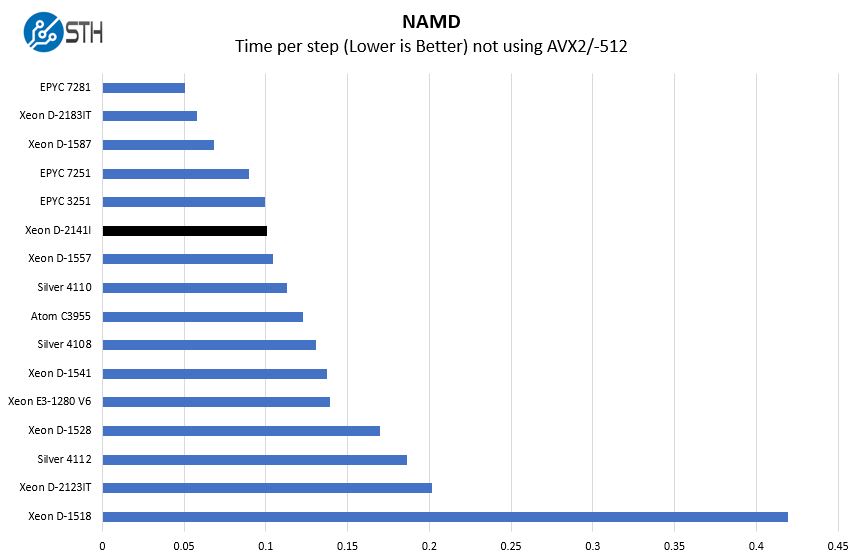
Here we see a trend that places the Intel Xeon D-2141I between the D-1557 and the EPYC 3251. Now, when we get to the GROMACS version where all of the AVX2/ 512 optimizations are turned on, you will see a big generational difference.
Sysbench CPU test
Sysbench is another one of those widely used Linux benchmarks. We specifically are using the CPU test, not the OLTP test that we use for some storage testing.
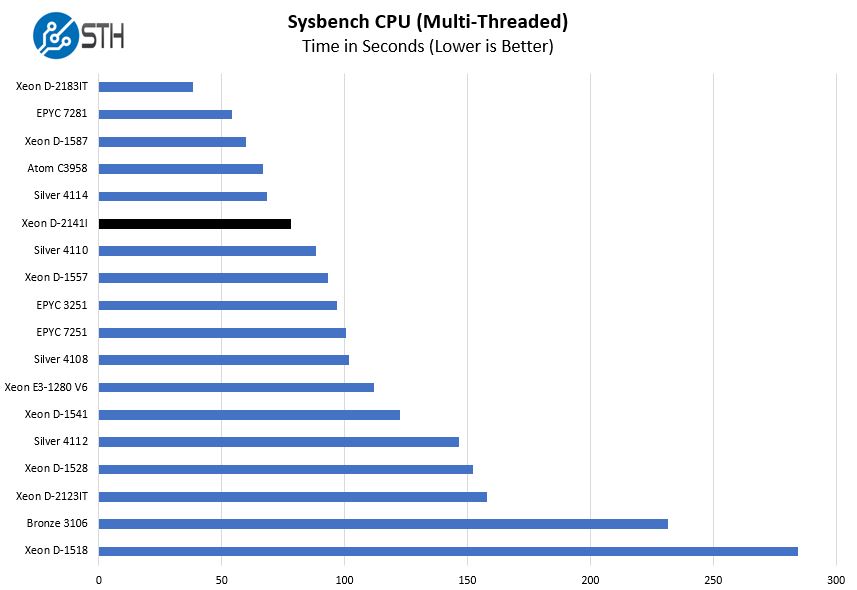
Here the Intel Xeon Silver 4110 and Intel Xeon Silver 4114 bracket the performance of the D-2141I. The Intel Xeon Silver 4110 is about the same tray price as the D-2141I. Intel is pricing according to this.
OpenSSL Performance
OpenSSL is widely used to secure communications between servers. This is an important protocol in many server stacks. We first look at our sign tests:

here are the verify results:
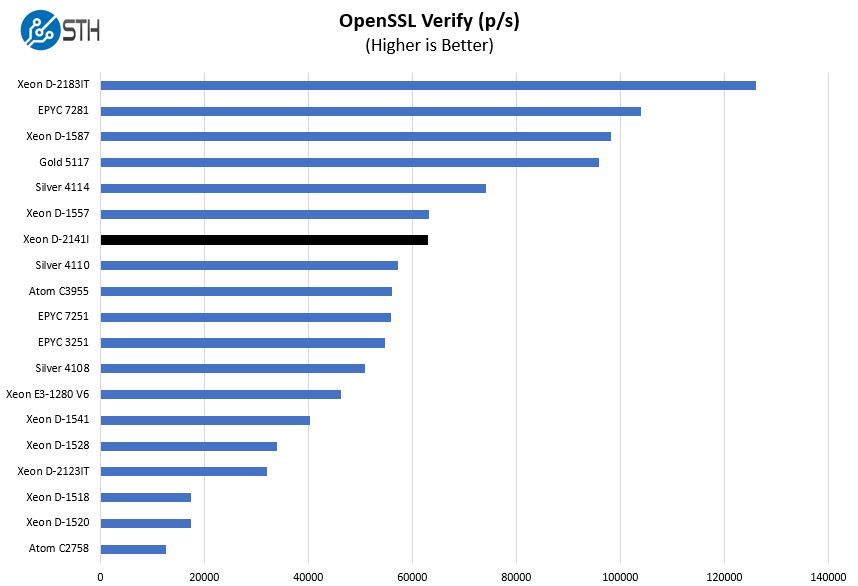
We have several different types of SKUs on this list. just to give some sense of relative performance beyond just directly adjacent SKUs.
UnixBench Dhrystone 2 and Whetstone Benchmarks
Some of the longest-running tests at STH are the venerable UnixBench 5.1.3 Dhrystone 2 and Whetstone results. They are certainly aging, however, we constantly get requests for them, and many angry notes when we leave them out. UnixBench is widely used so we are including it in this data set. Here are the Dhrystone 2 results:
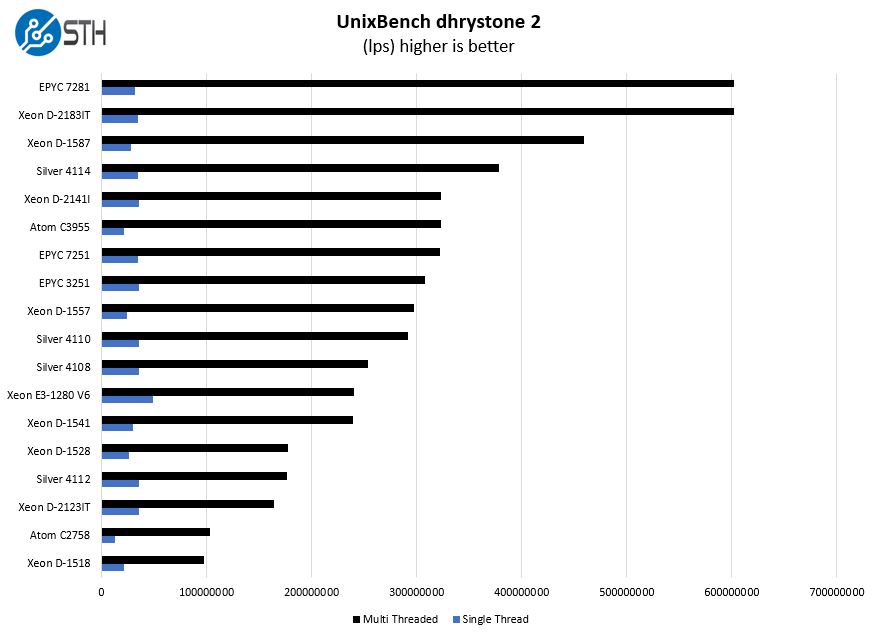
Here are the whetstone results:

Again, we see a solid showing from the Intel Xeon D-2141I. With a 3.0GHz clock speed, the single threaded results are excellent. Next, we have the most intriguing result.
GROMACS STH Small AVX2/ AVX-512 Enabled
We have a small GROMACS molecule simulation we previewed in the first AMD EPYC 7601 Linux benchmarks piece. In Linux-Bench2 we are using a “small” test for single and dual socket capable machines. Our medium test is more appropriate for higher-end dual and quad socket machines. Our GROMACS test will use the AVX-512 and AVX2 extensions if available.
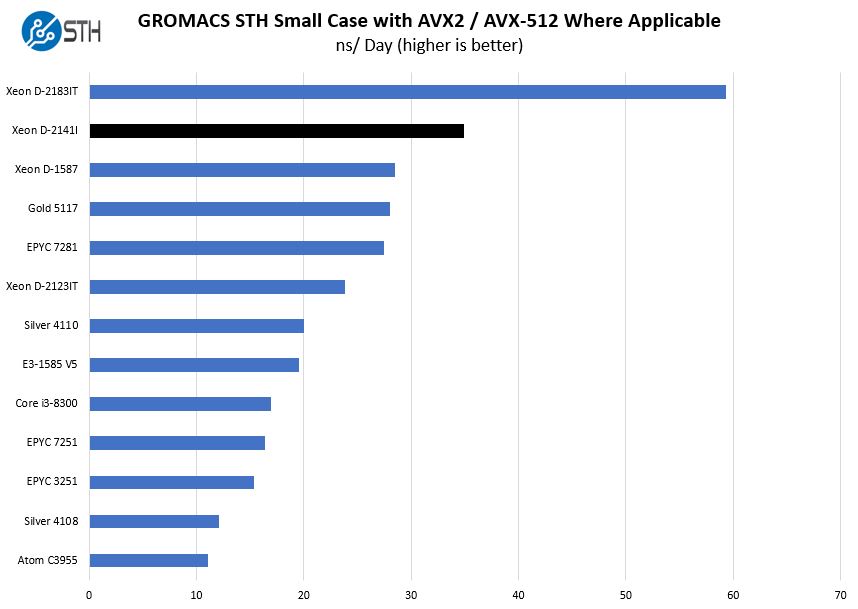
This is where things get really strange. Here we have a $555 embedded chip that is only supposed to support single port FMA AVX-512 out-performing the Intel Xeon Gold 5117, a 14 core single port FMA AVX-512 chip by a significant margin.
A possible explanation is that the Intel Xeon D-2100 series actually supports dual-port FMA AVX-512 not single port. At first, this may seem strange, but if you wanted to do inferencing at the edge without a GPU, perhaps that is a feature Intel snuck in.
We reached out to Intel to confirm this, and we received a response from an Intel spokesperson after conferring with the product team:
“[T]he Xeon D-2100 supports AVX-512 with 1 FMA”
On the other hand, the Intel Xeon D-2100 series AVX-512 application workload aligns much better to the dual port FMA results we have seen than to the single port results that the parts list in their spec sheets.
Chess Benchmarking
Chess is an interesting use case since it has almost unlimited complexity. Over the years, we have received a number of requests to bring back chess benchmarking. We have been profiling systems and are ready to start sharing results:

This is certainly a solid result where it is in the realm of other current generation 8 core processors.
Next, we are going to have the power consumption, market positioning, and our final words.




I always hear a lot of hype about AVX-512 on STH. You show test results with Gromacs, so I went to gromacs.org. Not to my surprise they promote GPU acceleration. What I do find surprising is, that we never see performance figures from STH on Gromacs with Deeplearning 10 and 11 (12 is so new that we can’t expect that). To me it seems a bit that STH is pushing AVX-512 and the rest of the world couldn’t care less, they just don’t give a sh*t.
Misha, from what I understand, Intel is pushing AVX-512 in hopes that it will be utilized for 5G implementation, whatever that is… AVX-512 is useful for several different edge utilities, including specific networking encryption/decryption forms. However, the cost is that the AVX-512 FMA units push the processor harder resource wise and it has to compensate for that. It compensates by throttling the core speed of the chip.
So the real question is this: In a real edge environment, where there is a mixed workflow of different processor intensive tasks (web serving, firewall, local storage cache, all kinds of stuff), do clients want a “feature” that will help a small percentage (today) of the workflow, but do so at the cost of slowing the rest?
Personally, I think the AMD EPYC 3000 series is a slam dunk for what we need now. Intel is betting on future software moving most of the data to the FMA, AVX-512. We’re still waiting on everything to go multithreaded… lol
Micah, I know what intel is trying to do with AVX-512. What wonders me is that STH never showed the price performance between Gromacs on CPU + CUDA vs. CPU with AVX-512 and in almost every review Gromacs CPU vs. CPU with AVX-512.
Maybe the Xeon-D doesn’t clock down as much as the Gold 5000 series?